Ruth Soukup's Blog, page 61
May 30, 2016
13 Easy Ways to Transform Your Space

Unstuffing our lives is literally a lifelong project. It means changing the way we thing and adopting a policy of fighting the flow of new stuff coming in, and keeping only meaningful and useful items, and learning to ruthlessly purge the rest.
And I’ll be honest–there may be times where you look around at your house, see the seemingly insurmountable piles of stuff still there and feel like there is no hope, like there is no way you’ll ever be able to dig yourself out of the mess. The effort just feels like way too much.
Believe me, I’ve been there too. More times than I can count.
But I’m also here to tell you–don’t give up!
Is my own house perfect? Hardly! There is still LOTS of room for improvement. We still end up with piles on our countertop and items sometimes even spill out of cupboards. I occasionally cringe when I open a bathroom closet door to see hairclips, bows and accessories tumble out. We’ve made big improvements, though. We’ve learned to simplify and we’ve accepted that fighting the flow of stuff will be a lifelong task.
Over the years I’ve also discovered that it is nice to get a jumpstart now and again! Sometimes all we really need is a quick win to get back our motivations. Thus, next time you feel like you’ll never really be Unstuffed, try these mini-purging, decluttering and organizing projects to get the ball rolling in your house.

1. Create a Collection Zone
One of the fastest and easiest ways to get your decluttering on the right track is to create a collection zone. This is an area where all of the out-of-place things in your house can go before they’re put away. Use a pretty basket or bin and put it in a frequently trafficked area of your house, like by the entryway, near the stairs or in the kitchen.
Make it a family rule to put all loose items in the collection zone, if they need to be put away. This means shoes, socks, jackets, toys…anything that would normally be on the floor, in the corner, and underfoot.
2. Clear the Counters
One of the biggest clutter zones is the kitchen counter. Clearing it off can instantly transform your whole living space! If you have appliances piled up, paperwork to go through, dishes and other items to take care of—do it! Get all that stuff off the counter and you’ll be amazed at how quickly your kitchen feels more open and clean!

3. Sweep the Surfaces
Are the surfaces of your home covered in knickknacks and figurines? Do you have to spend hours dusting? While decorative items can add charm and personality to your home, you might be surprised at how much cleaner and calmer your house feels without so much stuff.
Try a trial run and sweep all surfaces of your home for any little items you have out and about. Put all those trinkets away and out of sight for a few weeks. After a set amount of time, assess if you’ve truly missed your knickknacks or if you’ve hardly noticed their absence. Keep only the items you really love after the sweep.
4. Pitch the Pillows
Throw pillows are lovely and they add a homey element to your décor…but they also make your space feel cluttered because they end up on the floor, on the wrong couch, and/or looking messy. Basically, it took me awhile to get off the throw pillow bandwagon but I was amazed at how much more open, clean and comfortable my living room felt without all those pillows lying around. Feel free to donate your pillows if they’re in nice enough condition so they can provide decoration and comfort to another family.

5. Manage your Media
Books, magazines, DVDs, videogames—they all contribute to clutter and mess. With most movies, music and books available in digital format these days, you can rest assured that it’s ok to pare down your library to only those items you read, listen to or watch regularly. Opt for the digital format when it comes to books and magazines and try to reduce paper clutter as much as possible.

6. Take Back the Table
Our kitchen table tends to accumulate tons of “stuff.” Our girls love doing homework their there and my husband occasionally uses it as a desk. I myself have a tendency to leave important items on the table until they start to stack up. Make it a policy to only use your dining table for its true intended purpose: eating with your family.
Consider using a card table or temporary surface for games, puzzles and projects. This way you can pack it up and put it away when you’re done. (Plus, setting up a temporary table in your living room will keep you motivated to put it away when you’re finished rather than let it linger). Commit to using your desk for work projects and keeping the dinner table free from stuff.
7. Bed is for Bedtime
In addition to keeping your bed clean and made, you should limit your bed to specific activities. Good sleep hygiene practices mean you shouldn’t “hang out” in your bed, reading, watching television or taking Instagram shots of yourself enjoying coffee. Use your bed for sleeping and keep it made up and straightened the rest of the time.
I’ve been a big advocate for making your bed and I swear it makes a huge difference in the state of your home. Having a made bed will make your house feel tidy and organized. Once your bed is made, you’ve already accomplished something for the day. Plus, your sheets stay cleaner and feel better at night.

8. Beautify Your Bathroom
Your bathroom sink and vanity can easily become a disaster area. Ensure your morning routine goes more smoothly by keeping your bathroom organized. Not only that, but think of how gross it is when you see hair and makeup all over someone’s bathroom sink. (Ick!) Keep your bathroom countertop tidy and shut loose items in the cabinet or drawer when they’re not in use.
Keep a hand towel by the sink and use it to dry off fixtures and wipe off surfaces after you’re done each morning. Once a day, do a quick spot check of the bathroom. Close the toilet lid and the medicine cabinet, and be sure the countertops are clutter-free, towels are hung, and toilet paper is replenished. These little touches keep your bathroom ready for guests and make your house feel so much cleaner—and it only takes a couple minutes a day!
9. Do the Dishes
Keeping your sink free of dishes is the singular most important thing you can do to keep your kitchen tidy, besides clearing the countertops. Commit and get your family on board to rinse dishes as they’re used, then quickly move them to the dishwasher. If you don’t have a dishwasher, immediately use a dish wand to scrub, wash, dry and put away.
Not only will a dish-free sink make your home feel cleaner and less cluttered, but it will keep your kitchen smelling fresh as well.

10. Reduce your Rugs
Rugs can add warmth to your home, but they can also collect dirt and dust. Not only that, but they often end up curled up on the edges, looking shabby and worn. Plus, they’re very challenging to keep clean. Large rugs can’t be washed and can only be professionally cleaned. Smaller rugs never come out of the wash in the same state you put them in.
If you have wooden floors and feel you really need a rug for the room, try just one large rug with a low pile and have it regularly shampooed. For rooms with carpet or linoleum, you can probably skip the rugs all together.
11. Minimize Mini-Blinds
Mini-blinds, shades and curtains keep the cold and sunlight out and add privacy. Opt for one window treatment in a simple style or format. If you try to combine too many things—curtains, shades and drapes—it won’t only look dated, but you’ll be harboring dust and dirt from the outside as it comes in the window. Many window treatments are notoriously difficult to keep clean and dust-free. They become grimy and can even harbor mildew and mold.
If you can handle the lack of privacy go for less-is-more. If you require some shading, go for a minimal treatment like a sheer curtain or pleated shade with an anti-microbial treatment.
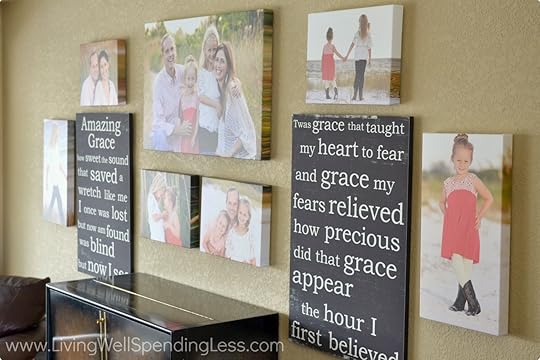
12. Bare Your Walls
By now you’re probably thinking, “Gee, does this woman have any décor up in her house?” I can assure you, we’ve done quite a few of these suggestions and we still have PLENTY of personality in our home.
That said, having wall-to-wall furniture or pictures can make your home look and feel cluttered and chaotic. Consider limiting your wall hangings to a few really meaningful pictures or pieces of art. We created frames where we can switch out our kids’ artwork and regularly rotate it. The gallery walls always stay fresh and interesting, but we don’t feel like we have wall-to-wall papers and posters hanging everywhere.
13. Declutter Your Desktop
Not only does paperwork pile up on your desk, but documents can also feel unmanageable on your computer. Declutter your desktop both physically and virtually. Use a pretty basket or inbox to corral your paperwork and keep it easy to find on your desk. Apply the if-then rules you’ve established and put the items to be taken care of in your inbox. If every piece of paper goes in one singular place, nothing will ever be missed. Commit to clearing the entire box every two weeks.
As far as your computer desktop goes, resolve to sort everything into file folders as you go. Take care of what’s on your desktop now by dumping it into one folder to be sorted and moving the folder to your documents. Periodically perform a “computer cleanse” (monthly seems to work well for me) at which time you delete any unwanted items, clear out any bookmarks or things you’re saving, and chip away at the “to be sorted” folder.
Tackle clutter in bite-sized pieces and you’ll quickly transform your space. By adding some strategies to tame the areas you use most frequently, you’ll achieve a bunch of quick and satisfying results to motivate you when you get to the more challenging areas. Go for it!

Pin It
The post 13 Easy Ways to Transform Your Space appeared first on Living Well Spending Less®.
May 27, 2016
5 Money Principles Every Newlywed Should Know

I am always happy to welcome back my friend Cherie Lowe from the Queen of Free, who has graciously joined us here at LWSL as a regular monthly contributor. Cherie is the author of the amazing book, Slaying the Debt Dragon, which she wrote after paying off more than $127,000 in debt! I love being able to bring her wealth of knowledge & experience on this subject to LWSL–please join me in making her feel right at home!
* * *
This is a Guest Post from Cherie at Queen of Free
She stands still with stars in her eyes and sparkles in her hair, naïve and full of hope for the future combined with a few unrealistic expectations of her husband to be. He watches her with sheer delight, taking joy in the bride he’s dreamt of building a future with even though he’s yet to realize she’s far from perfect. During a season when it feels like there’s a wedding every other weekend and a shower on the opposite ones, it’s easy to be caught up in the excitement of young love. There’s so much joy in celebrating a couple’s nuptials, of the anticipation of all that’s to come in their new little family.
If you know a soon-to-be newlywed couple, stop and say a prayer for their relationship. The difficult truth no one wants to hear on his or her wedding day is that close to 40% of marriages end in divorce. Ranking among the chief reasons why couples call it quits are fights over money. If you or someone you love is taking the plunge this year, be sure they read these 5 principles every newlywed should know about marriage and money.

Communicate (and Then Communicate Some More)
For years, my husband has quipped, “The death of communication is the birth of resentment.” On those days when he drives me crazy (because no matter how happily married you are, you’ll still drive each other crazy), the adage makes me so mad because I know he’s right. When you stop talking about your struggles, your feelings, your problems, you begin to resent your spouse. You may not even be fighting; you may just be busy in your own separate spheres of influence. This is precisely why weekly budget meetings are so important during the early days of marriage. You need to routinely practice talking about money – even if you don’t have very much to manage. Talk about upcoming expenses and money goals. Never had a budget meeting before? Read Four Ways to Improve Your Weekly Budget Meeting.

Dream Big
Unfortunately, the majority of couples who e-mail me struggling with money problems in their marriages see the conflict through a negative lens. One spouse typically is at his or her wits end with the other and wants to know how to “fix” the problem (ahem, the problem being the person they made sacred vows to on their wedding day). This adversarial approach rarely yields positive results. If you continue to view money as a me vs. my spouse issue, you will not only drive yourself crazy but you’ll begin to unwittingly place a wedge in between the both of you. While there is always work to be done when it comes to organizing monthly finances, it doesn’t have to be wearisome drudgery. Especially if you have a spouse who is resistant to change or budgeting, begin with the positive outcomes you’d like to achieve. Brainstorm what you will do or where you will go someday when you’re out of debt. Dream up an audacious savings goal and then get creative together on how to attain it. Begin with the end in mind. You’ll find shared vision not only consolidates your aims, it also captivates your hearts – together. Dreaming was essential in our journey of paying off over $127K in debt. Read five more ways we intentionally kept our marriage healthy while paying off debt.

Grocery Shopping Dates
It’s easy for any of us to have an opinion on how much should be spent on what category of spending. However, seeing can change our hearts and minds when it comes to setting a limit. This is why it’s incredibly important to engage in the process of setting your budget together. It’s a great idea to pay bills together, grocery shop together, and talk about realistic numbers for giving, saving, and spending together. The more you dialogue, the less likely you will be to set unrealistic expectations. Grocery shopping together on a regular basis provides a great platform to open channels of communication about how much your household expenses really are. You may not be able to engage in the practice every single week, but once a month or even once a quarter will assist in a more solid understanding of how much it costs to feed your family.

Realize Your Differences
Most financial gurus will tell you that in every marriage there is a spender and a saver. This could ring true for you and your future spouse. I’d hazard a guess that there’s another set of categories, too. In nearly every relationship I’ve encountered there’s an individual focused on short-term goals (think vacation, and Christmas) and one who concentrates on long term goals (think retirement and college savings plans). Here’s the good news: both you and your spouse were created with unique gifts and a purpose in life. Realizing your differences early on can help you avoid potential misunderstandings and conflict while also leaning into those gifts to strengthen your joint financial experience. If one of you is better at the nuts and bolts of setting up and maintaining a budget, then he or she should take care of those tasks. It’s a subtle dance of sharing responsibilities while communicating effectively about what you’re doing with your money.

Be Kind
Above all else, remember that your spouse is more important than any financial goal. Choose your words wisely when you speak to one another. Remember you chose to walk down the aisle. You promised to love, for richer or for poorer. Your words matter and the heart and the soul of your spouse matter even more. While it doesn’t seem like financial advice you’d receive from an “expert,” perhaps the very best thing you could do for your money is to be kind and encouraging to each other. Belittling or manipulating your spouse into desired behavior is not love, nor is it a picture of what a healthy marriage should look like.
My hope and prayer is that the stars would never disappear from your eyes when you gaze at your sweet spouse, that you would always be filled with hope for the future. Considering these five principles won’t guarantee a perfect marriage; however, applying them just might help you beat the odds with a love that lasts.
Cherie Lowe is an author, speaker and hope bringer.
Her book Slaying the Debt Dragon details her family’s quest to eliminate over $127K in debt in just under four years. As her alter ego the Queen of Free, Cherie provides offbeat money saving tips and debt slaying inspiration on a daily basis.

Pin It
The post 5 Money Principles Every Newlywed Should Know appeared first on Living Well Spending Less®.
May 25, 2016
10 Meals in an Hour™: Part 9

Here at Living Well Spending Less we are 100% committed to bringing you easy recipes that taste great and don’t take a lot of time, effort, or expensive ingredients to throw together. As a busy mom, I also want meals that can be made and frozen ahead of time to save time on hectic weeknights, especially as part of a Sunday Prep plan. My goal is to spend less time in the kitchen, not more, but I still want to be able to provide tasty meals that my family loves (and avoid eating out when we can!)
Over the past year and a half we have shared seven different 10 Meals in an Hour™ plans, which have each included 5 great freezer recipes that can be prepared together in about sixty minutes. (You can find the previous plans here: Part 1 , Part 2, Part 3 , Part 4 , Part 5 , Part 6, Part 7 and Part 8. They have been a huge hit, not only with our own families, but with many of your families as well, and we’ve absolutely loved hearing how much you all are enjoying these tasty recipes!
Today I am s0 excited to share with you another NEW series of awesome freezer to crockpot recipes.
As usual, in order to make the cut, each recipe must meet ALL of the following criteria:
Deemed delicious by both my kids and husband
No pre-cooking required (aside from browning sausage)
Freezer friendly
Easy to cook
Uses budget-friendly ingredients and pantry staples
In this one post you will find everything you need to prep 10 awesome freezer meals in about an hour of hands-on time (not including grocery shopping.) Just think, in just one quick weekend session you could have almost two weeks worth of absolutely delicious, family-friendly meals all ready to go!
Before you begin, you will need to gather your tools & supplies and also make sure that you have all your groceries on hand. I find it is easiest to go grocery shopping the day before I do my cooking. To save time unloading, only put away the items that need to be refrigerated. Finally, make sure your kitchen counters are cleared of clutter and sanitized and empty your dishwasher and sink of any dishes. (Check out this post for more tips on freezer cooking like a pro!)

Here are the five recipes we will be making:
Slow Cooker Sausage & Peppers
Simple Corn & Clam Chowder
Honey Sriracha Chicken
Slow Cooker Stroganoff
Easy Garlic Chicken
Here are the supplies you will need:
10 gallon size zipper freezer bags
labels or permanent marker
large mixing bowl
cutting board
sharp knife
garlic press
can opener
dry measuring cups
liquid measuring cups
dry measuring spoons
liquid measuring spoons
colander
Here are the ingredients you will need:
Produce
1 small yellow onion
3 sweet onions
1 8oz. package baby Portobello mushrooms
4-5 green bell peppers
2 8oz. bags baby carrots (optional: for cooking day only)
6-8 red potatoes (optional: for cooking day only)
1 jar minced garlic
20-30 cloves garlic
1 bunch celery
fresh thyme
fresh parsley
1 bunch of green onions
Frozen
2 15oz. bags frozen white corn
Pantry Staples
Dried Parsley
Olive Oil
Soy Sauce
Honey
Sriracha sauce
Red Pepper Flakes
Black pepper
Salt
Canned/Dry Goods
2 cans cream of mushroom soup
1 can cream-style corn
2 bags egg noodles (optional:one per cooking day only)
1 box rice (optional: for cooking day only)
29 oz can tomato sauce
28 oz can crushed tomatoes
2 32oz. carton chicken stock
3 32oz. carton vegetable stock
White wine
Red wine
Oregano Vitality Essential oil (optional)
4 6.5oz. chopped clams, drained(cooking day only)
Dairy
2 16oz. container sour cream
Butter
1 cup whipping cream (cooking day only)
Meat
6-8 pounds boneless, skinless chicken thighs or breasts
2 pounds ground beef or vegetarian crumbles
2-3 20 oz. packages mild Italian sausage
4-6 slices of cooked bacon (cooking day only-optional)
Bread
Italian bread (cooking day only)

Be sure to print the following pages before getting started:
Printable labels (designed to work with Avery 8163 shipping labels)
Printable Shopping List
Printable Prep & Prepare Instructions
Be sure to also print the following recipes:
Honey Sriracha Chicken
Slow Cooker Stroganoff
Easy Garlic Chicken
Slow Cooker Sausage and Peppers
Simple Corn & Clam Chowder
PREP
Prep your bags—either print labels using these ready-made printable labels or use a permanent marker to label each bag with the name of the recipe, date prepared, and cooking instructions. DO NOT SKIP THIS STEP! While you might think that you’ll remember what is in every bag, I promise you will forget!
Brown sausage and set aside
Chop onions and set aside
Chop green peppers and set aside.
Sauté peppers and onions for sausage and peppers recipe, set aside.
Peel and mince garlic and set aside
Open up all the cans needed for prep day and set aside.
Prep raw chicken
PREPARE
Prep Simple Corn & Clam Chowder using instructions found here . Divide soup into 2 freezer bags, press out excess air, and seal well. Place bags in refrigerator.
Prep Slow Cooker Sausage & Peppers using instructions found here . Divide sausage into 2 freezer bags and cover with sauce mixture, press out excess air, and seal well. Place bags in refrigerator.
Prep Easy Garlic Chicken using instructions found here . Divide chicken into 2 1-gallon freezer bags, then divide garlic cloves and thyme into bags over top of chicken. Then divide broth mixture over top of chicken. Place bags in refrigerator.
Prep Slow Cooker Stroganoff using instructions found here . Divide mixture into 2 freezer bags, then press out excess air and seal well. Place bags in refrigerator.
Prep Honey Sriracha Chicken using instructions found here . Place chicken into 2 freezer bags and cover with mixture, then press out excess air and seal well. Place bags in refrigerator.
Once all prep is complete, place all bags in freezer until needed. After you’ve made your meal plan for the coming week, consider setting an alert on your phone to remind you to take your bag out to thaw the day before you plan to make it.
* * *
Have you tried making 10 meals in an hour yet? What tricks or tips can you share?

Pin It
The post 10 Meals in an Hour™: Part 9 appeared first on Living Well Spending Less®.
May 23, 2016
Five Fantastic Family Weekend Trips

Summer is just days away which means nothing but good things–sunshine & barbecues, flip flops & fireworks and, best of all, family vacations!
As a family, we have taken some pretty big road trips, including a six week motorhome journey that included stops at Mount Rainier, Yosemite, Death Valley, and the Grand Canyon, just to name a few! A few summers ago we took another big trip that included 15 states in 29 days. While I’m sure some people might think spending that much time in the car with two young kids sounds insane, these road trips are truly some of our best memories. In fact, this summer, as we prepare to move back to Washington State from Florida, we are getting ready to embark on one more big adventure, this time hitting Chicago, Mount Rushmore, and Yellowstone.
Needless to say, we’ve picked up quite a few tips and tricks along the way! One of the most important takeaways? Stick to a budget. No matter how desperate you are for a vacation, don’t break your bank just to go. If your budget is tight this year, you can always schedule a staycation at home, or visit friends or family a few towns away and make the most of it.

If a family trip IS within your budget, but your budget is still tight, a road trip is definitely the way to go. Even a reasonable flight fare gets pricey when multiplied by four (or more!) Choose destinations where you have friends and family—and be sure you show appreciation for their hospitality. If you’re a gracious guest and you offer to return the favor, most friends will be happy to let you crash with them for a night or two. If you must stay in a hotel, check sites like Hotels.com for the best price.
To save on meals, whip up some snacks and pack a cooler or two to get you through your journey. That said, food and sightseeing are often the best parts of any road trip, so make sure you reserve a little wiggle room in the budget for good eats! Our family road trip policy is to stop for pie whenever we see a cute diner or a mom-and-pop restaurant.
Of course sometimes trying to figure out where to go is the hardest part, and so our team did some research and put together five fantastic family weekend trips all around the country—almost anyone in the U.S. should be able to easily reach one of these destinations by car, depending on your location. These destinations offer plenty of great family-friendly activities, so use this list to jumpstart your vacation planning. We can’t wait to see the pictures!

Cape Cod, Massachusetts
The quintessential East Coast vacation spot, Cape Cod offers plenty of family-friendly activities, sightseeing, and hands-on fun for everyone! With its down-home attitude, it’s not nearly as pricey as you might think, making Cape Cod a budget-friendly destination.
Pick up Kids on the Cape for a calendar list of fun kid-friendly activities. Don’t miss the Cape Cod Children’s Museum in Mashpee for younger children and the Marine Animal Discovery Center in Buzzard’s Bay. The Animal Discovery Center is a non-profit rehabilitation center for wild animals native to the area including seals, turtles and birds.
Visit the Plimoth Plantation for a look into a real 17th century colonial settlement and a great hands-on history lesson. As part of the Plimoth experience, you can visit the Wampanoag Homesite where Native People dressed in traditional clothing discuss history and heritage. Art lovers might enjoy a visit to the Edward Gorey House and Museum, where the Amphigorey and Gashlycrumb Tinies author, illustrator and animal advocate lived for many years. (Check out his fondness for bats!)
Get your “pirattitude” on at the Whydah Pirate Museum, where you can touch 300-year-old coins and treasure, plus see cannons, swords and other pirate artifacts. Follow it up with some mini-golf at Pirate’s Cove Adventure Golf. The entire family will also enjoy the Heritage Museum and Gardens, where kids can join in a scavenger hunt and other garden activities including a Friday craft project, while mom and dad enjoy the amazing flowers and beautiful art and history featured in the three museums.
Cape Cod is very bike-friendly. You can rent bicycles throughout the 25-mile Cape Cod Rail Trail. Biking can be a healthy and inexpensive way to get around as a family, plus there are plenty of drop-off and rental locations (so you don’t have to do the full 25 miles). From the relatively flat trail, you can enjoy the natural landscape including cranberry bogs, ponds and salt marshes.
Don’t miss the Cape Cod lighthouses, the most famous of which is the 66 foot tall Highland Lighthouse. During certain times of the year, you may even see whales from the spectacular view of the Atlantic!
You can tour the Cape Cod Potato Chip Factory and enjoy a few free samples while you’re there. When you’re in New England you have to have some ice cream (of course), so Four Seas is the place to go! For the classic lobster roll or clam strips, try the Clam Shack or Cobie’s (which offers burgers and fries as well for non-seafood lovers). Don’t miss a chance to stock up on classic candy at the Kandy Korner (saltwater taffy!) and get some souvenirs at the 1856 Country Store.

Chicago, Illinois
Unlike the average “big city,” Chicago has a friendly, small-town feel in certain areas and neighborhoods, and there’s TONS to do. Not only that, but you can easily save by staying in the suburbs and taking the Metra rail system or the elevated train (known as “The L”).
From the Botanic Garden to the Brookfield Zoo, Chicago and the surrounding suburbs are filled with amazing things to do, see and check out. Head to the Navy Pier to ride on the 15-story Ferris Wheel and get a birds eye view of the entire city.
Bike Chicago offers bike rentals (including tandem bikes) and has stations spread throughout the city. Biking along Lake Michigan provides some of the best views and outdoor fun, including the fountains at Millennium Park.
The Museum Campus is a beautiful lakefront area that holds the Shedd Aquarium, the Adler Planetarium, and the Field Museum (home of Sue, the largest most complete T. Rex skeleton!)—and all three are within short walking distance of each other. However, seeing everything there is to see at all three locations in one day may prove impossible! The Museum of Science & Industry is another don’t-miss Chicago museum experience, packed with family-fun activities, and check out the Art Institute of Chicago to see some of the amazing works.
If you plan to hit up several museums, consider investing in a CityPASS Chicago to save up to 53% on admission. (It’s truly a great deal if you’re a museum-loving family.)
While you’re in the Windy City, if you’re looking for lower-key and/or on-the-cheap activities, check out ChicagoKids.com for more options, like visiting a local farm, checking out theater or arts & crafts activities, or visiting an amusement park packed with go-karts, laser tag, jumping parks and more. The Lincoln Park Conservatory, Lincoln Park Zoo and the City Gallery offer free admission. Plus, of course, you can always enjoy a picnic on the beach at Oak Street.
As far as food, Chicago is famous for several favorites, including Chicago-style hotdogs, deep-dish pizza, gourmet popcorn, and Italian beef sandwiches. We loved the pizza at Home Run Inn when we visited the Windy City, but also try the deep dish at Giordano’s. Garret’s Popcorn on Navy Pier offers the “Chicago Mix”—a strange combination of cheese and caramel corn that somehow works together.
For hotdogs, any stand will do, and if you really like hot dogs, you must try a Chicago dog or “red hot” as they’re locally known. It’s an all-beef hotdog on a poppy seed bun loaded with chopped white onions, yellow mustard, bright green sweet pickle relish, tomato, a dill pickle spear and sport peppers. (Just don’t ask for ketchup, as most Chicagoan’s insist it’s unacceptable on a hotdog.) For Italian beef, Portillo’s is famous for a reason. (You can also get a Chicago dog there, if you like.)
If you’re still looking for family-fun things to do, LEGOLAND Discovery Center is in nearby Schaumberg and you’ll also be within a short drive of Six Flags Great America. You can also get some quiet time in at the Chicago Athenaeum International Sculpture Park. (Incidentally, Schaumberg is also great for less-expensive accommodations.)

Monterey Bay, California
Monterey is the perfect California destination—beautiful views, adorable animals, gorgeous weather! Most people think California wine country isn’t a family-friend spot, but that couldn’t be further from the truth. If your family is outdoorsy and loves gorgeous scenery, or if you have budding marine biologists, this is your perfect destination.
When you’re in Monterey Bay, you’re only 45 minutes from Henry Cowell Redwoods State Park, which is a must-do on your way there or back. Spectacular, enormous redwoods abound and you may see banana slugs, deer, birds, and even coyotes.
Visit the Monterey Zoo where many retired animal performers have found sanctuary. This is an educational zoo where the whole family can gain some very hands-on experiences. The Monterey County Youth Museum keeps the education going with hands-on theater, building and sports activities.
Whale watching is one of the famous attractions of Monterey. For the highlight of your trip, going out on a whale-watching expedition or tour is well worth it, as it’s a one-of-a-kind experience. Athletic families with teens and older children may want to check out Adventures by the Sea for some paddleboarding or kayaking.
The other big draw in Monterey is the Monterey Bay Aquarium. This is home to over 550 species of marine life from mammals to fish. They’re dedicated to the study and preservation of marine animals and the aquarium experience is second-to-none. The Aquarium offers spectacular views and it’s housed in a former sardine cannery!
The Pacific Grove Museum of Natural History is another hotspot for your amazing nature experience. It’s one of the oldest natural history museums and they even offer a Monarch sanctuary where the butterflies winter. In the spring and summer, you can see the darling harbor seal pups. You can also visit the Pt. Pinos Lighthouse (the oldest lighthouse on the west coast), the Steinbeck Center, and of course Pebble Beach Golf Course (definitely worth a drive-by).
For even more nature appreciation, visit Pinnacles State Park—with its clear water, breathtaking views and gorgeous volcanic formations you’ll be blown away. California Condors and other wildlife frequent this park, and it’s a prime viewing, hiking and (for the experienced) climbing location.
As far as food (and fun), Old Fisherman’s Wharf cannot be beat. You can get a caricature sketched of you and your family and whale watch while you enjoy seafood and treats! Check out Crabby Jim’s for great clam chowder. Domenico’s offers the classic seafood experience.
For healthy California bistro fare, try the Wild Plum Café in Old Monterey. The Carmel Bistro also offers beautiful food and a variety of cuisines. Enjoy a picnic and some peaceful beauty at the Mission San Antonio de Padua, one of the stunning missions on the Central Coast. The Soledad Mission is also a can’t-miss!

Savannah, Georgia
Savannah is an amazing vacation destination from Tybee Island to City Market, it’s a thriving, elegant city with great weather, great history and amazing sites.
In Georgia, it’s all about the history and the waterways. Catch a Dolphin Tour with Dolphin Magic. This guided tour offers a great exploration of the history of the waterways, plus you’ll see the Waving Girl and the Tybee Lighthouse.
Savannah is a very bike-friendly town, and Fat Tire Bike Rental will help you get on two wheels. They also offer up ideas for bike tours.
Take a marine life tour with “Dr. Joe” from Coastal Environmental Analysis. You can learn all about the animals and habitats you see along the beach. It’s a great lesson in ecology and the environment for both kids and parents. You can also explore marine life at the Tybee Island Marine Science Center, where you can learn about the Turtle Project.
Take in a few history lessons while you’re in Savannah. Enjoy a riverboat cruise or tons of outdoor activities (boating, kayaking, fishing and more) through Outside Hilton Head. In autumn, you can catch the Tybee Island Pirate Fest, complete with a petting zoo, costume contest, pirate parade, games and fun. Get the full history experience by taking an Old Savannah Tour. You can explore a Haunted Tour (Savannah is “America’s Most Haunted City”), or try an Architecture Tour or a Historic Overview.
For food, Savannah’s historic center, City Market offers a variety of choices. Go international with the British Pie Company. Satisfy your sweet tooth at Savannah’s Candy Kitchen. You can take a food tour to get the full Savannah Taste Experience. Check out Gerald’s Pig & Shrimp for true Georgia barbecue.

Austin, Texas
Austin is coming into its own lately as a fantastic travel destination. Known for its amazing nightlife, food and music, you might be surprised to learn that it’s also very family friendly as well!
The website do512family.com offers a week-by-week calendar of family and kid-friendly activities to keep you busy in Austin for the entire year. From the Annual Butterfly Festival to children’s theater, there’s a jam-packed schedule of activities. The City of Austin also runs the Millennium Youth Entertainment Complex, which is a dream world of bowling, arcades, skating and theater!
Kiddie Acres is an amusement park with miniature golf, a carousel, and pony rides. Think of it as a State Fair that’s always open. The kid-friendly Bollock Museum at UT is a great resource for Texas history and Native American artifacts. They also offer an IMAX theater.
Beautiful Zilker Park offers kayaking, fishing, and lakeside fun at Lady Bird Lake. You can rent paddleboards and boats, kayaks, canoes and more. There’s a gorgeous hiking and biking trail, too. You can cool off at Barton Springs Pool and (of course) there’s plenty of music with Austin City Limits Music Festival and Blues on the Green.
The Austin Zoo is a rescue and rehabilitation facility that helps animals from other zoos and facilities with health issues. Many of the animals at the facility are retired or endangered. Austin Zoo is also an educational and conservation organization.
Dinosaur enthusiasts will love Dinosaur Park—an outdoor park with life-sized replicas of all their favorites. The Thinkery at Austin Children’s Museum is very innovative with hands-on labs and experiments. Kids can also explore living history at Pioneer Farms, which offers archery, art projects and plenty of classes and activities.
Volente Beach is a waterpark with a pirate ship and a sidewinder, plus lots of other great ways to cool off in the Austin sun. If you’re a big fan of water, you can also check out Capital Cruises Boat Tours. (The bat-watching tour gives you a chance to see the largest urban bat population.)
Texas is known for its amazing food! The Texas Kids Kitchen offers cooking classes and camps for kids who want a taste of the full culinary experience. Enjoy food truck culture with Via313 and their gooey delicious pizza. Tacos abound in Austin and I’ve heard the best taco truck is said to be Veracruz All Natural—plus it’s super cheap! Tacodeli is also a fun and funky taco location. Enjoy vegetarian fare at Bouldin Creek Café or go meaty with Franklin Barbecue.

Travel Smart
Wherever your wheels take you, remember to sign up for email alerts and discount notifications through Groupon, Restaurants.com and LivingSocial. For more deals, try Amazon Local or search local publications from your destination to help you save even more on your trip. I also like to request a free travel brochure from the local Visitors Bureau no matter where I’m traveling.
Always ask about student discounts and kids’ admission. Many places offer group passes, free reentry and other deals, but you have to request them ahead of time (or at the time of purchase). Do your research and enjoy your vacation!

Pin It
The post Five Fantastic Family Weekend Trips appeared first on Living Well Spending Less®.
May 20, 2016
How to Let Go of Stuff Guilt

What is it about stuff and guilt?
Over the past couple of months, as I have found myself doing lots of interviews to promote the release of my new book Unstuffed, this is one question that has come up again and again and again–why do we feel so guilty about all the stuff in our lives?
We feel guilty about getting rid of clutter because we may have paid a lot of money for it, or because we don’t want to be wasteful, or because someone gave it to us, or perhaps even because it represents all the things we said we were going to do and then didn’t. (Hello craft supplies!)
But whatever the reason for keeping it, this hanging on to clutter causes a different kind of guilt–the guilt that comes from feeling like our lives are cluttered and out of control.
It’s a never-ending guilt cycle!
Believe me, I totally get it.
In my own life, my husband and I have struggled a lot with this very issue, especially over the past few years. You see, in 2011, my dear mother-in-law, Marie passed away, leaving behind an entire house–84 years worth–full of things. There were clothes, furniture, boxes of paper and notes. There were photos and jewelry, knickknacks and books. It felt like it would never end.
The thing is, all this stuff wasn’t just a meaningless pile of junk we could simply discard and move on from. These things were her belongings. They were her memories. They meant something to her, and it was hard to think of just tossing them out so coldly, like a lifetime of holding on to things wasn’t worth keeping.
But then, just two years later, my sister-in-law Linda suddenly passed away. She had been extremely close to my daughters and it was a devastating blow. As her closest relatives, we again were responsible for taking care of all the things she left behind, and we had another entire house full of stuff, two people’s lifetimes of belongings—neither of which belonged to us.
The guilt was terrible. In fact, at one point my husband broke down, saying “it feels like I am throwing her life away.”
But we also knew, deep down, that we couldn’t keep it all. We were already buried.
And the reality was that my mother-in-law and my sister-in-law were so much more than just the stuff they left behind. They were kind and generous and loving and smart and funny and so much more. Equating their lives with a pile of stuff was only cheapening their memory.
We finally had to come to the realization that memories and stuff are not the same.
And we had to let it go.
The reality is that at some point, it is no longer practical, healthy or reasonable to hold on to things we don’t need simply because you’re trying to hold on to a memory. It’s no longer reasonable to keep items that don’t fit the needs of your family. We can’t force our families to conform to some idea of what our house “should” look like when it doesn’t serve our actual needs.
In the case of my husband and I, we had to assess and make hard choices. We went through the items and we condensed it down to only the things we really needed. I kept a few high-quality items that were very meaningful to me. I also knew these were things that would both last and probably end up being something my daughters would want.
Why We Become So Attached in the First Place
One of the reasons we become so attached to items is because of the idea of scarcity. We are blessed with mostly abundant lives where we’re able to meet our needs and have enough.
For many of us, growing up we might have been faced with times of hardship and times when we struggled. Maybe we saw our parents struggle to bring home a paycheck or put food on the table. If you had grandparents who grew up during the Great Depression, you saw the after-effects. Often they would save all kinds of items—paper, packaging, wrapping, rubber bands—all because they knew what it was like to have nothing.
In our lives today, most of us are so blessed because our needs are being met. We might struggle, of course, but usually we’re able to at least feed, clothe and shelter our children. It makes perfect sense why those who have been through the trauma of poverty might now hold on to things a little more intently.
Similarly, if you’ve gone through a traumatic experience, you might hold on to items because you identify them with happier memories. We use this sort of “magical thinking” to ward off bad experiences. Or we may believe that holding on to items will somehow shield us from the pain of loss or grieving.
This can be one of the most difficult things to work through when it comes to letting go of stuff. Oftentimes, we may need to talk to someone about our struggles, whether it’s depression, anxiety, a reaction to grief, or a traumatic event. When we’re holding on to emotional baggage, it can literally become physical baggage we carry around with us.
The other reason we hold on to stuff? Simply because it comes on in! If we aren’t constantly and diligently “fighting the flow” of stuff into our homes, it can pile up and multiply like bunny rabbits. I swear, no matter how little I purchase for my children and how few gifts they receive, there is somehow always a surplus of incoming stuff!
When I took my kids toys away, I think people had visions of my daughter playing with a corncob doll like Laura Ingalls Wilder in an empty bedroom. I can assure you all, my daughters have a stunning amount of stuff, no matter how much I throw away.
When I went on a recent trip to the Dominican Republic through Compassion Bloggers, I was pretty astounded and humbled by the staggering weight of true poverty. The very fact we have soft beds, a roof over our heads, food to eat, clean clothes to wear, and water to drink puts us leaps and bounds ahead of most of the world in terms of abundance.
Recognizing what we have and the items we need versus simply “want” can be a life-changer when it comes to stopping the flow of stuff. You may think you NEED another candle, a black long-sleeved tee, or a pair of running sneakers that match your hoodie, but really? Most of us truly have enough.
Having the Courage to Let Go
Once you realize how much you have and what you really need, it can be easier to let things go. It also helps to recognize the deeper underlying reasons you might be holding on to items.
It isn’t easy. At all.
But I’ve found it helps keep reminding myself that people and stuff are not the same, and that I need to let go of anything that is not currently useful, despite who gave it to me, and despite how much it cost. When I approach the task of decluttering with those guidelines in mind, it helps alleviate a lot of the guilt.
One simple way to help you get through your purging process is to take those items you can’t seem to part with and simply put them away for a while. Send them on a little vacation. Clear the surfaces of your house—clear the bookshelves and the knickknacks and the countertops and the nightstand. Take those “decorative” items and put them away for about eight weeks.
After the eight-week period, bring them back out and consider whether or not you really missed them. If you still aren’t sure and you can’t quite bring yourself to let them go, ask yourself if it would help to know they’re going to a good home, where they will be appreciated and used.
I find this method to be particularly effective with things like clothing, kitchen appliances and other items, which are useful but not often used. If someone else can find a purpose for them, it’s time to set them free!

Once in a while, you might even shock yourself: you might forget you even put some of these items away. A few years ago, before I cut back to a 40-hanger closet, I put away my “hot summer” clothing (it’s Florida, so there’s not a huge difference between summer and winter clothes) and brought out my fall items. I’m ashamed to admit, I made it clear until the following June until I realized I had completely forgotten about some of the items I’d put in storage. That was when I knew it was time to cut back on some of my clothing.
The three questions I find helpful are:
Do I really use this?
Does it work and is it in good condition?
Do I really like and want it?
If you use these three screening questions, you can determine if almost anything is serving your needs. You do, of course, have to get past the idea of “I like and want everything I have.” It seems to be the question that trips up most of us. Of course we ‘like’ most things in our home, but do you REALLY like it? Sometimes when our homes become too full, it’s hard to see the things we REALLY like because they’re buried among the things we kinda-sorta of like.
I’ll be honest–this guilt thing is something I’m still working on. There may always be things that I end up holding on to because I feel guilty, but ultimately the freedom that comes from letting go is worth fighting for.

Pin It
The post How to Let Go of Stuff Guilt appeared first on Living Well Spending Less®.
May 18, 2016
Simple Corn & Clam Chowder

While the weather’s starting to heat up, there’s still nothing I love more for a simple but hearty meal than a bowl of delicious homemade soup. Luckily this corn and clam chowder transitions beautifully into summer, making it the perfect recipe to enjoy all year long.
And let me tell you, enjoy it you will, because it is quite possibly my favorite soup recipe to date. The fact that it comes together fast with just a few minutes of prep, then freezes beautifully and goes straight to the crock pot is just icing on the cake, as far as I’m concerned!
To make it as part of a freezer cooking day, just split the soup into multiple bags, then throw it right into the freezer–no cooking required!
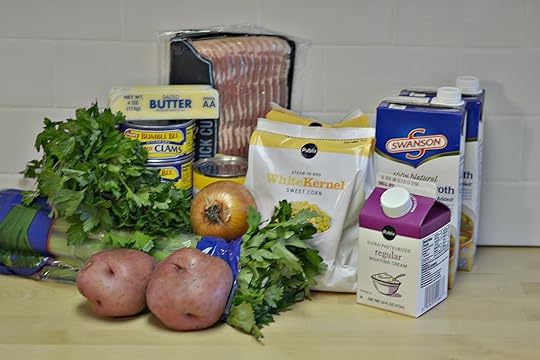
Here is what you need:
1 can cream-style corn
2 15oz. bags frozen white corn
1 small yellow onion, chopped
2-4 stalks celery, chopped
8 cups vegetable broth
1/2 cup fresh parsley, chopped
salt and pepper to taste
4 6.5oz. chopped clams, drained(cooking day only)
1 cup whipping cream (cooking day only)
1/2 stick of butter (cooking day only)
4-6 slices of cooked bacon (cooking day only-optional)
2 large red potatoes, washed and diced (cooking day only-optional)
1 bunch of green onions, chopped (cooking day only-optional)
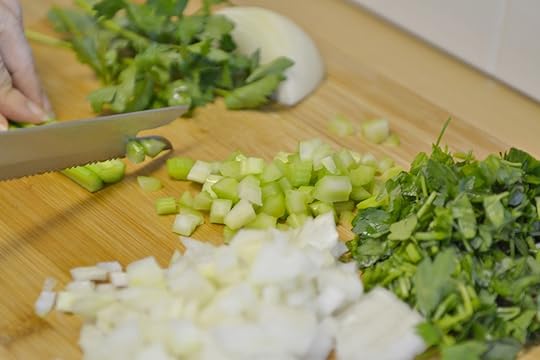
Step 1: Chop onions, celery, and parsley; set aside.
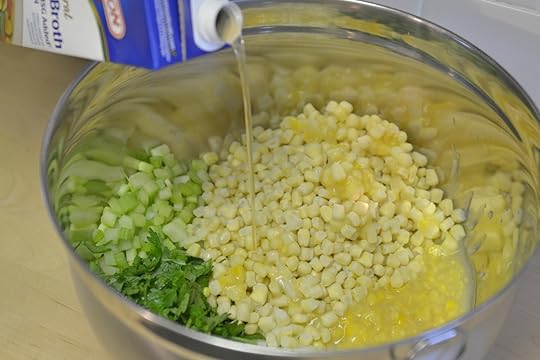
Step 2:In large bowl, mix together onions, parsley, celery, creamed corn, frozen corn, and broth.

Step 3: Divide mixture into 2 gallon size freezer bags. ( be sure to label bags first)

Step 4: On cooking day, place frozen soup directly into slow cooker. Set to high and cook for 3-4 hours or on low for 4-5 hours. *If adding diced potatoes, do so with about an hour of cooking time left. (Do not freeze diced potatoes with soup mixture, they will turn black)

Step 5: Before you are ready to serve: drain clams and add to slow cooker, wait 3 minutes then stir in whipping cream and butter until butter melts. Add salt and pepper to taste.

Step 6: Ladle into bowls and top with crispy bacon (optional) and green onions.
Print This!
Recipe: Simple Corn and Clam Chowder
Summary: This simple soup is so creamy and delicious, perfect for a light Spring meal.
Ingredients
1 can cream-style corn
2 15oz. bags frozen white corn
1 small yellow onion, chopped
2-4 stalks celery, chopped
8 cups vegetable broth
1/2 cup fresh parsley, chopped
salt and pepper
4 6.5oz. chopped clams,drained (cooking day only)
1 cup whipping cream (cooking day only)
1/2 stick of butter (cooking day only)
4-6 slices of cooked bacon (cooking day only-optional)
2 large red potatoes, washed and diced (cooking day only-optional)
1 bunch of green onions, chopped (cooking day only-optional)
Instructions
Chop onions, celery, and parsley; set aside.
In large bowl, mix together onions, parsley, celery, creamed corn, frozen corn, and broth.
Divide mixture into 2 gallon size freezer bags. ( be sure to label bags first)
On cooking day, place frozen soup directly into slow cooker. Set to high and cook for 3-4 hours or on low for 4-5 hours. *If adding diced potatoes, do so with about an hour of cooking time left. (Do not freeze diced potatoes with soup mixture, they will turn black.)
Before you are ready to serve: drain clams and add to slow cooker, wait 3 minutes then stir in whipping cream and butter until butter melts. Add salt and pepper to taste.
Ladle into bowls and top with crispy bacon (optional) and green onions.
Preparation time: 7-10 minutes
Cooking time: 4-5 hours on low or 3-4 hours on high
Number of servings (yield): 4-6

Pin It
The post Simple Corn & Clam Chowder appeared first on Living Well Spending Less®.
May 16, 2016
How to Tame Your Paper Clutter

Have you ever wondered why the clutter that comes from paper and information (a.k.a. digital data or virtual paperwork) clutter seems so much more stressful than all the other types of clutter or disorganization in our lives?
I have a theory.
You see, while those stacks of papers piling up on the counter might be unsightly, and the 427 unread emails in your inbox might feel overwhelming, the reality is that in one fell swoop they could both be gone. All you’d really have to do is grab the whole stack of paper and throw it in the recycling bin, or check the “select all” box in your email and move all those messages to the trash, and you’d be done. Problem solved.
If only it were that simple, right?
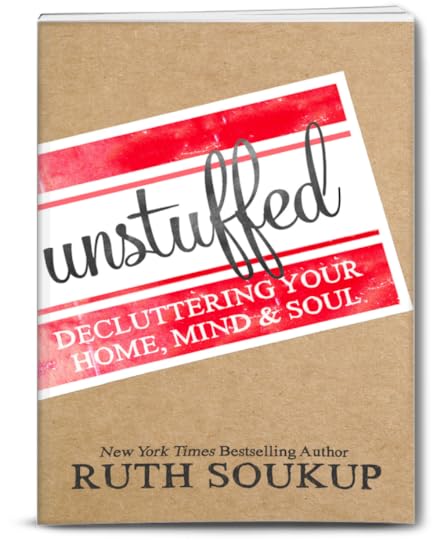 The reality is that information clutter is different than other types of clutter because it is not actually the stack of paper that is causing the stress, but the obligation that gets attached to it. Each piece of paper, each email, requires some sort of action or decision on our part.
The reality is that information clutter is different than other types of clutter because it is not actually the stack of paper that is causing the stress, but the obligation that gets attached to it. Each piece of paper, each email, requires some sort of action or decision on our part.
Our paperwork problem is really more of a procrastination problem.
This is a subject I tackle in depth in my new book Unstuffed, because it is one that I have certainly had to deal with–and continue to face–in my life. Because let’s face it–paper is everywhere! So what’s the solution? How do take back our lives from this sea of information that threatens to wash us away?
Here are a few ideas for how to tame the paper clutter in your life:

Going Paperless Only Solves Half the Problem
We often try to flight the flow of paper clutter by going “paperless,” so we sign up for electronic billing and correspondence whenever possible. Unfortunately, while this reduces physical paper clutter, it creates a slew of electronic documents we have to also be responsible for. If you’re like me, your desktop, documents folder and inbox always feel like they’re overflowing.
We live in a day and age where information and data is constantly produced and exponentially growing. Take photographs, for instance. Over the past few years, the number of photographs taken has grown to a trillion in 2015. We will hit 1.7 trillion by 2017, and it just keeps on growing. That’s an unimaginable number of photos. With digital photography, there’s no reason to discard photos or wait for just the right moment. Unfortunately, this means our photo collections can be almost impossible to organize or do anything with.
Do you remember a few years ago, when scrapbooking was all the rage? People spent time, money and energy creating beautiful photography books, but the trend ended up declining, as people had more and more photos, because parceling them down to just the “best of” became more challenging.
Get a Handle on Paper & Data Clutter: First Fight the Flow
So, how do we get this data and paper clutter under control? Well, the first step is in having a solid plan and system for heading off clutter before it even begins to infiltrate your home. As much as I would love to just dump all that paper in the bin, it does contain important, albeit overwhelming, pieces of information.
Just as with any form of clutter, the main goal is to stop it before it even comes in the door. This means implementing a screening system to determine what to do with each piece of paper before it gets slung on the counter or piled on the coffee table.
Fighting the flow also means that when you’re out at the store, don’t take the free weekly flyer at the checkout. Unsubscribe from catalogues and junk mail lists. Don’t sign up for weekly reminder emails or feeds from companies you aren’t interested in. Make a concerted effort to stop it before it comes in.
When it comes to photography, consider keeping ONLY the best of the best photos. It can be a challenge to delete photos (especially of kids or babies) and I know every moment and action may seem precious, but preserve the memory and your sanity with one or two photos and delete the rest. If you have boxes of printed photos, archive the best ones by scanning them in, and again, discard what you aren’t going to enjoy. Old photos are a rare and therefore a more precious commodity, so you might have a difficult time parting with them, but narrow it down as much as you can.
Another area requiring some discernment is kids’ work and art. My girls are very sensitive about their work being thrown away. We keep all of their best work in a special box in the closet. At the end of the school year, we go through the box and pare down to the very favorite pieces to be kept in a scrapbook. For artwork, we display it for a time and replace it in our “gallery” or we take a photo and keep a digital copy.

Handle It & Move On: Ensure Fewer Touchpoints with a System
It’s time to implement an information filtering system. This means creating some hard and fast rules you can stick to, to assess clutter when it comes in and quickly know what to do with it.
So many of us have a pile of bills, mail, cards and envelopes we need to open and deal with. We toss everything on a desk, in a drawer or in some sort of inbox, and then when it finally overflows, we end up trying to make heads or tails of a pile of things we’re behind on. It becomes stressful and frustrating.
By implementing a set of rules, dealing with the influx of stuff becomes much easier to deal with. Eventually, and with consistency, these rules become automatic habits, and the flow of data and papers will be much more manageable and easy to deal with. There’s a rule in business about touchpoints and how much handling the same piece of information can cost in terms of money and productivity when you don’t deal with it right away. Take heed of this advice. How much time are you wasting sorting through large paper piles every week?
The best rule of thumb is to handle everything as little as possible. Deal with it right away or get it to where it needs to be as quickly as possible. If you have systems in place to deal with things the moment they hit your mailbox, you’ll be able to keep everything moving along smoothly.

Implementing If-Then Paperwork & Data Clutter Rules
One of the best ways I’ve found to quell the flow of data is to set up “if-then” rules for paperwork and data clutter. For example, IF a piece of mail is junk THEN it goes right into the recycling bin. IF a permission slip is sent home from school THEN it gets signed right away and returned to the folder in the backpack.
Here are a few examples of if-then rules I use, but you can of course modify them to fit your needs.
IF a piece of mail is a bill to be paid, THEN it goes into the “to be paid” box on my desk, which is reviewed twice a month.
IF a piece of mail is a statement that needs to be filed (and very few pieces of paper need to be physically filed), THEN it goes into the “to be filed” box on my desk, which is emptied twice a month.
IF a piece of mail is a personal note or thank you card, THEN it gets opened, read, and then either saved in a keepsake box (if it’s something special) or recycled.
IF an invitation is received, THEN it gets a decision and a response immediately. IF the response is yes, THEN take a picture of the invite and add it to your calendar and discard. IF the response is no, THEN throw it away and move on.
IF the school sends home a note or menu to be signed, THEN it gets signed immediately and sent back to school.
IF my kids bring home a test or other work to show me, THEN it gets looked at, commented on, and added to the schoolwork bin in their closet, which gets sorted and emptied at the end of the school year.
IF my kids bring home a new piece of artwork, THEN it gets hung in their room or in our gallery until they bring in something new, at which point it gets added to the schoolwork bin in their closet.
IF I get spam or junk email I don’t want, THEN I will take a second to unsubscribe so I don’t get any more.
IF I get a chain email, THEN I will immediately delete it.
IF I get an email needing a response, THEN I will respond as quickly as possible with as brief a response as possible, using a canned response if possible.
IF I get an email that doesn’t need a response, THEN I will archive it, and move on.
IF I get an email requiring a more in-depth response, THEN I will add the item to my calendar to be addressed, and keep the item in my Inbox folder, which I clean out once a week.
IF I get a text message while I’m busy, THEN I will respond during my next break.
IF a text message requires more than three lines to respond, THEN I will simply pick up the phone and make a call.
IF I get a Facebook message, THEN I will send a canned response requesting an email instead.
IF I’m reading an article and want to remember something, THEN I take a photo of it (paper) or add it to my “to be read” list (electronic), which I review once a week.
IF I take photos, THEN I will immediately delete all but the very best.
IF my computer desktop gets messy, THEN I will take a few minutes to drag and drop my files into appropriate folders.
IF I need to save a document I’m working on, THEN I will put it into the appropriate location on my computer.
With these rules, my response to paperwork and data clutter have become automatic, so I don’t have to think about each bit case by case. I know when an item comes across my path, there’s already a plan for it—and it is SUCH a relief! My if-then rules ensure paperwork and digital docs don’t sit around in piles, untouched, or hang over my head, needing to be addressed.
This system also works very well with my husband and daughters. My girls know exactly where their paperwork is going to go when they get home, and they know what they need to do with it. Likewise, it eliminates their anxiety about getting permission slips signed and remembering to “remind Mom” about upcoming events and to-dos. They just make sure everything goes in their folder and they know it will be dealt with right away.
With a plan in place and a few rules, you can keep the flow of paperwork and data clutter at bay!
Pin It
The post How to Tame Your Paper Clutter appeared first on Living Well Spending Less®.
May 13, 2016
14 Ways to Recharge Your Internal Batteries

Last week I did something I’ve never done before–something I don’t think I ever would have even considered, had my husband not suggested and encouraged it.
I went on a personal retreat.
For four whole days, I did nothing but read books, go for long walks and hikes, do yoga, take long baths and lay by the pool. I completely unplugged from work and literally retreated from the world.
It was nothing short of incredible, and it was a powerful reminder to me–someone who normally thrives on being busy–that sometimes rest is the most productive thing we can do.
And let’s face it–clutter and chaos are the opposite of restfulness. Not only do our homes become chaotic, but our schedules also get full of things we need to do, deal with, and take care of. Life can feel like an endless parade of carpooling, pickups and drop-offs for lessons and activities, and running errands all over the city, not to mention keeping up with all the obligations at work or school or church.
It’s no wonder we need a break once in a while!
While these days, many of us use tech to tune out, the reality is that screen time will never leave us feeling recharged and refreshed. Instead, it just makes us feel constantly connected and overloaded with information.
Instead of going to Facebook or Pinterest, or playing a game of Candy Crush on your phone, why not try to find more restful ways to really relax? Taking a break from tech gives us a chance to recharge our own batteries and helps us feel more mindful and aware of our surroundings. This mindfulness leads to a sense of control and empowerment. Suddenly, you feel like you can “do the things!” when before you might have just felt like checking out.
Believe it or not, our mental “getaway” doesn’t need to be an elaborate vacation or expense escape. Here are fourteen simple ways to recharge your internal batteries—without breaking the bank.

1. Go for a Walk
Probably the simplest and most cost-free solution to relaxation is to slip on your shoes and go for a walk. Just get out there. Walk in rain, walk in the snow or walk in the sun. While walking with your kids or spouse can be lovely, sometimes it’s nice to just go for a walk by yourself (or take your dog).
When you go for a walk, it’s not about speed-walking, listening to loud music, or even trying to lose weight (although all of those things can be part of it too, if that’s what truly relaxes you). Instead, it’s about mindfulness, listening to the sounds around us, and enjoying the sites of the journey. Breathe in the fresh air and really notice what’s going on in your environment. Even a ten or fifteen minute walk can give you the boost you need.
2. Enjoy a Manicure or Pedicure
Of course we all love going to the salon and getting a mani/pedi, especially during the summer months. It can be such a boost to feel the salt scrub and to sit in the massage chair while someone else pampers you.
Even if you can’t afford the salon, you can still easily give yourself a little DIY mani/pedi boost at home. Pick a happy color that makes you feel energized and take some time to really give it your attention.
Soak your hands and feet in warm water, and use a stick to push your cuticles back. Use a scented lotion or coconut oil and work it into your hands and feet. Trim your nails and file them into shape. Then, use the polish to add a little shine and color. You can pamper yourself for literally pennies, and if you take the time to really concentrate on what you’re doing and make it special, it can feel just as great as a day at the salon.

3. Give Yourself Some “Spa Time”
Speaking of pampering yourself, have your ever treated yourself to a home spa treatment? Years ago I worked in a spa—and I loved it! It was so fun to see our clients come in all excited, then watch them get pampered and enjoy doing something nice for themselves. People are rarely sad at the salon. It’s a great way to boost your mood and brighten your day.
You can create that spa day feeling at home! Do something extra special for yourself—use an exfoliating salt scrub, and put on a fluffy robe. Light scented candles or use a diffuser and essential oils. Keep the lights turned down low, and use a mask or special skin treatment. Whiten your teeth with a little baking soda and hydrogen peroxide. Give your hair a deep condition. I guarantee you will feel lifted!
4. Take a 20-Minute Nap
I’m not a huge napper, but the benefits of taking a nap during the day can boost concentration and improve your mood, especially if you’re a person who loves naps (or someone who just needs to get a better night’s sleep).
Take twenty minutes to cozy up somewhere comfortable and warm. Rather than just trying to catch some winks in a chair or on the couch, try to make your nap something really special. Turn the lights low, wrap up in a soft blanket, and even get a pillow out.
The idea is to make a nap seem like a special luxury and reward, rather than something you feel guilty for “sneaking in.” When you’re using a nap to recharge your batteries, make it a treat.

5. Get a Little Exercise
If you’re someone who enjoys exercise, get your endorphins going to keep you feeling charged up and ready to take on the world. Exercise keeps your heart healthy and can help boost your mood and keep your emotions in check. If you struggle from anxiety or depression, exercise is a natural solution.
You don’t have to belong to an expensive gym or health club. Simply put in a DVD or look for exercise videos on YouTube. If you’re committed to going tech-free, lace up your sneakers and go for a walk or run. If all else fails, turn on some music and dance around your living room. It’s about getting your heart pumping and your mood-boosting endorphins going. You’ll feel the energy.
6. Color!
Adult coloring books are all the rage these days. Using pencils or crayons to fill in repeating designs can be just as soothing and relaxing for adults as it is for kids.
You don’t need to buy an expensive book to participate in the coloring trend. There are tons of drawings you can print off online, or go ahead and sneak a page from your kids’ coloring book. You can even try looking through your own bookshelf. Many books feature simple line-drawn illustrations.
Taking colored pencils to a piece of paper and illustrating color variations from light to dark, or creating a simple drawing of trees or flowers can make you feel calm and refreshed.

7. Read a Book
While I love my Kindle as much as the next gal, try to take a break from technology and try opening a good old-fashioned book. Pick something light and relaxing to read, like a biography or fiction.
If you aren’t a big reader, skim through a magazine or page through a cookbook for fun ideas. (No frantic searching for a dinner recipe to stress about tonight!)
8. Work in Your Garden
Whether you have a true green thumb or just a brownish-green one, everyone can enjoy getting outdoors and getting our hands a little dirty! Try planting some veggies or lettuce in a planter or pot. If you have existing flowerbeds, weed and rake the dirt surrounding the plants.
When you’re working in your garden, be mindful of the world around you. Notice the smells and feelings you experience in the dirt and grass. Feel the breeze and the sun as it hits the back of your neck. Let the process become a sensory experience to ensure it’s much more relaxing than just “weeding the garden.”
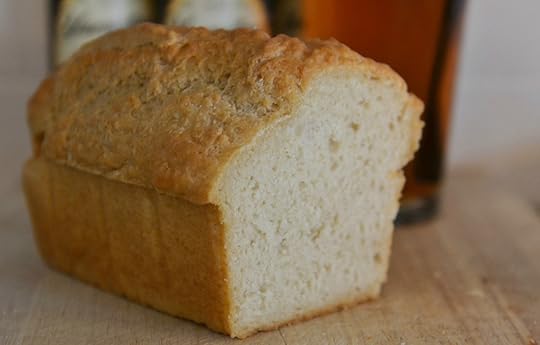
9. Bake Bread
I LOVE LOVE LOVE homemade bread. A good crusty loaf, a soft loaf, beer bread—there’s really nothing better than delicious, fresh bread. Try making a loaf of easy yeast bread or rolls. The very act of kneading the dough, letting it rise, and creating something your whole family can enjoy is very therapeutic.
If yeast bread isn’t your favorite, try making a quick bread like banana, zucchini, pumpkin or carrot. Even if you’d rather not have it in the house, it makes for a great gift for neighbors, and you’ll double the recharge effect by doing something nice for someone else.
10. Use Essential Oils
Essential oils are a big part of my life and my family. They’re amazingly useful when it comes to staying healthy. They smell amazing and they can be used in so many applications—from healthy cleaning solutions to diffusion for all sorts of benefits.
Try using lavender to relax, peppermint to energize, or orange to awaken and refresh. You can use the oils topically, so try putting a few drops on a cotton ball or tissue to give you a little boost during the day.

11. Call a Friend
Very few things in the world can recharge our batteries like a conversation with a good friend. Don’t make it a complaint session or even a chance to “vent.” Instead, try reframing your approach to the conversation and make it about uplifting the both of you and truly connecting.
Listen to your friend and talk about the things important to both of you. Make plans for the future and exchange funny or inspirational stories. Sometimes a quick call is all you need to reset your mood and feel renewed.
12. Journal
At the times in my life when I’ve most struggled, I’ve found that writing things out can be immensely helpful, and yes—even energizing. Some of us might not be traditional “journalers,” but jotting down your thoughts, lists, plans and memories in a notebook can help get it off your plate and out of your brain.
If you find you need a chance to reset and recharge your batteries, explore your “whys” in your writing. What’s making you feel drained and what can you do to make yourself feel better? Write it out and you might be surprised at the results.

13. Take a Bath or Shower
It’s amazing what a nice bath or shower can do to reset your levels and get you going. If you really need a recharge, use a soothing shower gel and the “nice” conditioner and shampoo—and go all out. If you like, put on some music or nature sounds to make your shower an experience.
If you prefer a bath, light candles and break out the Epsom salts and bubble bath, of course. Try something with an invigorating citrus scent to wake you up and give you a boost of energy.
14. Give
There’s no better way to recharge your batteries than to think of a way to give to those around you. It doesn’t need to be a grand donation to charity and you don’t need to build an entire Habitat for Humanity house (though both are great ideas). For an easy mood lifter, try simply doing something nice for someone close to you or committing a random act of kindness.
Pay for the next guy in line at Starbucks. Drop off cookies or that zucchini bread to a neighbor. Fix a favorite meal for your kids or spouse. The idea is to do it with intention, awareness and joy.
Recharging your batteries doesn’t need to be an expensive process, and it shouldn’t require you to do something time consuming and out of the ordinary. Pick a simple activity that makes you feel good, and put away your cell phone and technology so you can really enjoy and savor the moment!
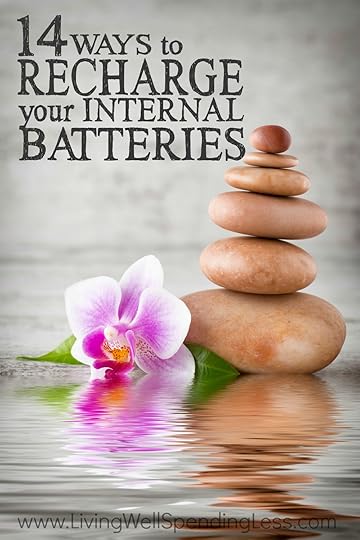
Pin It
The post 14 Ways to Recharge Your Internal Batteries appeared first on Living Well Spending Less®.
May 11, 2016
Slow Cooker Sausage & Peppers

I’ll readily admit that over the past two years I have become more than a little obsessed with freezer cooking, and with developing new recipes that my kids and husband will love. But seriously, what’s not to love? Not only are they quick & easy to throw together, they save us a ton of money on groceries (and especially on eating out.) Better yet, they make our sometimes hectic weekdays SO much simpler! There is nothing better than knowing at the end of a crazy day that dinner is already in the crockpot!
So yes, I’m obsessed. You’re just going to have to bear with me.
To be perfectly honest, I was a little nervous about how these slow cooker sausage and peppers would turn out, but they were a HUGE hit. There is some prep cooking required for this recipe but it is so worth it!
To make it as part of a freezer cooking day, just split the sausage, sauce, peppers & onions into multiple bags, then throw it right into the freezer.
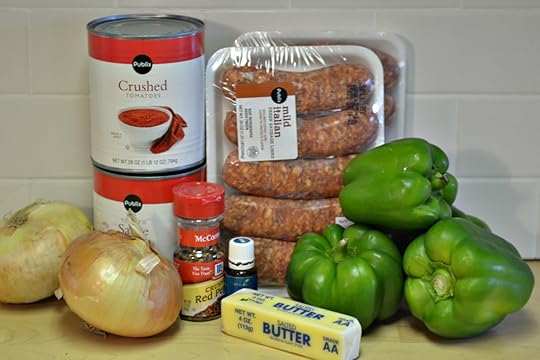
Here is what you need:
2-3 20 oz. packages mild Italian sausage
2 large onions, sliced
4-5 green bell peppers, sliced
1/2 teaspoon crushed red pepper flakes
29 oz can tomato sauce
28 oz can crushed tomatoes
4-6 tablespoons butter
salt and pepper
1 drop Oregano Vitality Essential oil (optional)
Italian bread (cooking day only)

Step 1: Chop onion and set aside.

Step 2: Slice green peppers into strips;set aside.

Step 3: Brown sausages in a pan with 2 tablespoons of butter. Then remove sausage from pan and cut into thirds and set aside.

Step 4: Place 2 more tablespoons in pan and add peppers saute until softened. Then add last 2 tablespoons of butter and saute onions till softened.

Step 5: In a large bowl, mix together sauce, crushed tomatoes, red pepper flakes, Oregano Vitality Essential oil and peppers and onions.

Step 6: Divide sausage into 2 gallon size freezer bags ( be sure to label bags first.) Divide sauce mixture over top sausage.

Step 7: Thaw if frozen; cook in crockpot on low for 5-6 hours or high for 3-4 hours; until sausage is cooked all the way through. (Note-don’t worry if your sausage isn’t all the way thawed. It can also cook from frozen, it might just take a little longer.)

Step 8: Serve with sliced Italian bread and enjoy!
Print This!
Recipe: Slow Cooker Sausage and Peppers
Summary: This classic Italian dish comes together so quickly and will taste like you spent hours in the kitchen.
Ingredients
2-3 20 oz. packages mild Italian sausage
2 large onions, sliced
4 – 5 green bell peppers, sliced
1/2 teaspoon crushed red pepper flakes
29 oz can tomato sauce
28 oz can crushed tomatoes
4-6 tablespoons butter
salt and pepper
1 drop Oregano Vitality Essential oil (optional)
Italian bread (cooking day only)
Instructions
Chop onion and set aside.
Slice green peppers into strips;set aside.
Brown sausages in a pan with 2 tablespoons of butter. Then remove sausage from pan and cut into thirds and set aside.
Place 2 more tablespoons in pan and add peppers saute until softened. Then add last 2 tablespoons of butter and saute onions till softened.
In a large bowl, mix together sauce, crushed tomatoes, red pepper flakes, Oregano Vitality Essential oil and peppers and onions.
In a large bowl, mix together sauce, crushed tomatoes, red pepper flakes, Oregano Vitality Essential oil and peppers and onions.
Divide sausage into 2 gallon size freezer bags ( be sure to label bags first.) Divide sauce mixture over top sausage.
Thaw if frozen; cook in crockpot on low for 5-6 hours or high for 3-4 hours; until sausage is cooked all the way through. (Note-don’t worry if your sausage isn’t all the way thawed. It can also cook from frozen, it might just take a little longer.)
Serve with sliced Italian bread and enjoy!
Preparation time: 5-10 minutes
Cooking time: 5-6 hours on low in crockpot or 2-3 hours on high.
Number of servings (yield): 4-6

* * *
What is your favorite slow cooker recipe?
Pin It
The post Slow Cooker Sausage & Peppers appeared first on Living Well Spending Less®.
May 9, 2016
How to Bring Order to Your Life in Just One Day

This is a guest post from Michael Hyatt
Life comes at us in a swirl of hopes, worries, obligations, and commitments, doesn’t it? Sometimes that swirl can feel like a tornado. And there we are—holding on for dear life, hoping the storm doesn’t blow all our priorities into the next county.
We know it’s not sustainable. Our busy lives heap stress on our health, our relationships, and our work. So how do we calm the storm and bring order to all the crazy in our lives: the overdue projects, overstuffed calendar, and overlong to-do lists?
Here’s one simple solution I’ve been using for years. It’s called a Life Plan, and it only takes *one day* to create one for yourself.

What Difference a Day Can Make
A lot can turn on a single day, right? Think back to your graduation, your wedding, or the day you became a parent. One day is sometimes all it takes to alter the direction of every day thereafter.
So what kind of day am I talking about? It would have to be momentous to compare with your wedding or a child being born. Yes, indeed.
This is the kind of day that can determine the ongoing vitality of your marriage, the health of your family, and frankly most everything else in your life: spiritual engagement, financial security, professional aspirations, significant friendships, and more.
If you use this one day to create a Life Plan, you’ll end with a brief written document that will give direction and order to every important area of your life.
I detail the Life-Planning process in my brand new book, Living Forward: A Proven Plan to Stop Drifting and Get the Life You Want, and for one week only, Living Well Spending Less readers can get access to more than $360 in exclusive bonuses with your purchase of the book. You can get all the details HERE.
In the meantime, here are the five key ingredients to creating your life plan:

1. One dedicated day
Yes, I’m talking about one day away from the storm, a timeout from the tempest. No work, no kids, no nothing. This is probably a much needed break, but I find more than most are resistant.
It might be a difficult investment. I get that. But it’s worth ten times whatever it costs you because this day will help you:
envision a compelling future
clarify your priorities
maintain balance across all areas of your life
evaluate all the opportunities and commitments that come your way
face reality and improve almost any situation
Honestly, this is just way too important to allow for distractions. You have to commit to disconnect.
2. A dream for the future
I bet you have one or two of these, though we sometimes lose track of them in the midst of all the crazy. That’s something we cannot afford to do.
We can make the present more meaningful and manageable by filling it with the future. If we live with end in mind, we can make decisions today that determine the quality of our tomorrow. What would that mean for your marriage, your family, your health, your finances?
Imagining a compelling future is like spotting goal post. It provides direction for our momentum. We can start orienting our actions toward a target.
It might sound a bit creepy, but in Living Forward I actually recommend writing your eulogy as part of this exercise. Why? Because a compelling vision for how you want to be remembered can be enough to influence your actions right now.

3. A pad of paper
You can use anything really: a new or favorite journal, Evernote, or just a yellow legal pad—whatever will let you get those dreams down and sharply defined.
And make sure you do. It’s far more important than it might sound at first. No dream can survive the tempest. We’ve all had that experience, right? For a dream to endure, it has to be written down.
Remember, a Life Plan is a brief written document. A record of your work on this day is critical if you want to experience more than a temporary benefit from stepping outside the storm.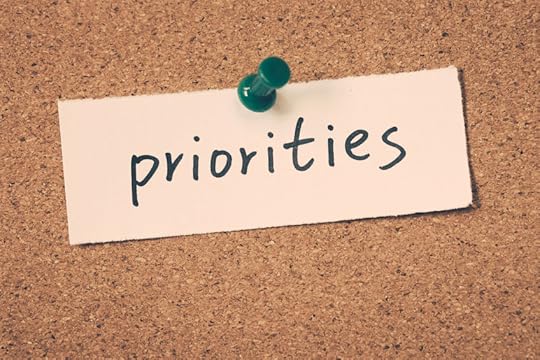
4. A plan for your priorities
This will come as you write. Think about your dreams for your health, spiritual life, marriage, family, friendships, and all the other areas of your life.
These represent your most important priorities. In Living Forward language, these are your “Life Accounts.” Create a special section for each and prioritize them by their importance to you.
What would a positive balance look like in each account? What would it take to enrich them? Answering these questions on paper for later review is critical because we lose visibility in the whirlwind.
We often focus on one or two but miss the rest: Maybe we’re taking good care of the kids but neglecting our health. Or we’re working toward our deadlines and giving our marriage the leftovers.
Developing a written plan for these priorities will enable you to dedicate the right amount of time and attention to each—not more and not less.
5. A commitment to follow through
Now imagine you’re done. You’ve got a written Life Plan you can use to shield yourself from the storm. It contains a list of all the important areas of your life, what you’re dreams are for those areas, and a plan to reach those dreams.
The trick is using it come Day 2. I recommend reviewing your Life Plan every day at the beginning. I also recommend you review it quarterly to see how you doing and revise it once a year to make sure you’re still on track and accounting for all the developments of the previous twelve months.
Commit to using a Life Plan and you’ll have clarity about your present and a clearly marked path to a future that inspires you.
Are You Ready to Calm the Crazy?
I’ve been using this process for more than a fifteen years, and it’s seen me through challenges with my family, ups and downs in the economy and at work. I still get caught in the whirlwind from time to time, but my Life Plan points my way forward when I lose focus.
If you want that same kind of clarity and direction, I recommend you check out Living Forward and invest one day to calm the crazy and quiet the storms in your life. Remember to use this link for a special offer JUST for LWSL readers and get more than $360 in additional bonuses with your purchase of the book.
Michael Hyatt is a popular bloggerand the coauthor of Living Forward: A Proven Plan to Stop Drifting and Get the Life You Want. He is also the creator of 5 Days to Your Best Year Ever.™ and author of the New York Times best seller, Platform: Get Noticed in a Noisy World. In addition, He is the founder of Platform University.®
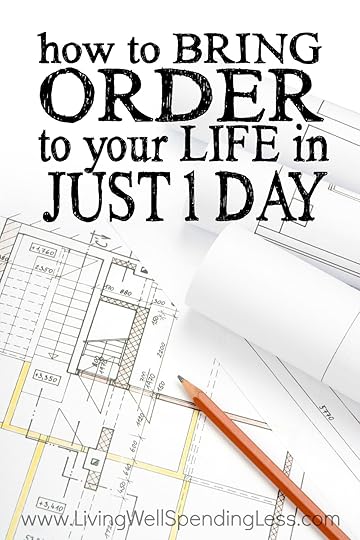
Pin It
The post How to Bring Order to Your Life in Just One Day appeared first on Living Well Spending Less®.









